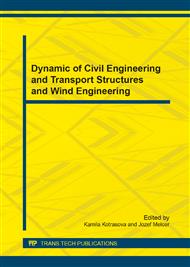p.130
p.136
p.142
p.148
p.152
p.156
p.162
p.167
p.171
Non-Destructive Tracking of Structural Changes of Concrete Mixtures during Thermal Stress
Abstract:
This paper deals with the application of the method of impedance spectroscopy to testing of cement-based composites prepared from a mix of cement mortar and quartz sand, which were intentionally degraded by high-temperature treatment (in the temperatures range from 25 °C to 400 °C). The monitoring of structural changes in the thermal stress is very important, for example for determining the reliability of the whole structure. Based on the Debye theory of dielectric the models were created, their applications and received parameters measured dielectric material is characterized and discussed the uniqueness of determining the values of model parameters. Development of electrical parameters and permittivity at each temperature areas reliably show these structural changes and thus the structural reliability.
Info:
Periodical:
Pages:
152-155
Citation:
Online since:
August 2014
Authors:
Price:
Сopyright:
© 2014 Trans Tech Publications Ltd. All Rights Reserved
Share:
Citation:


